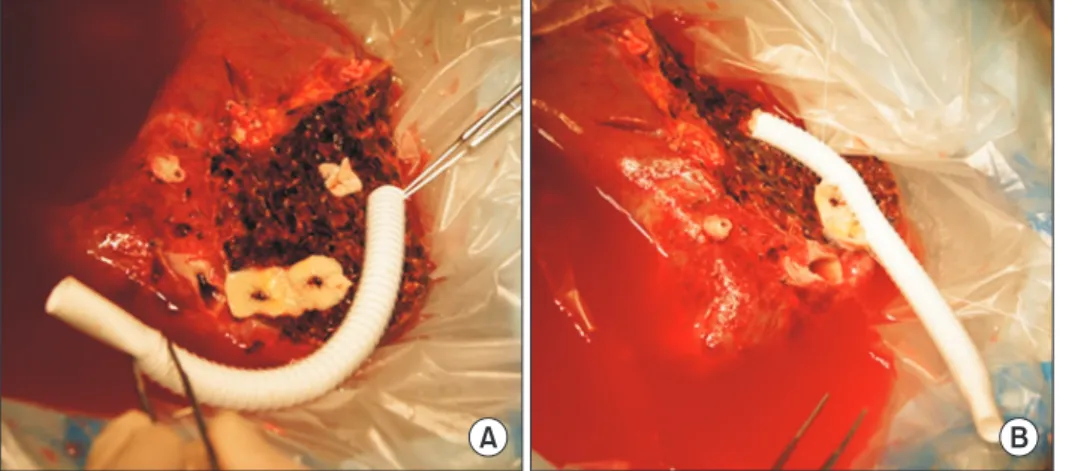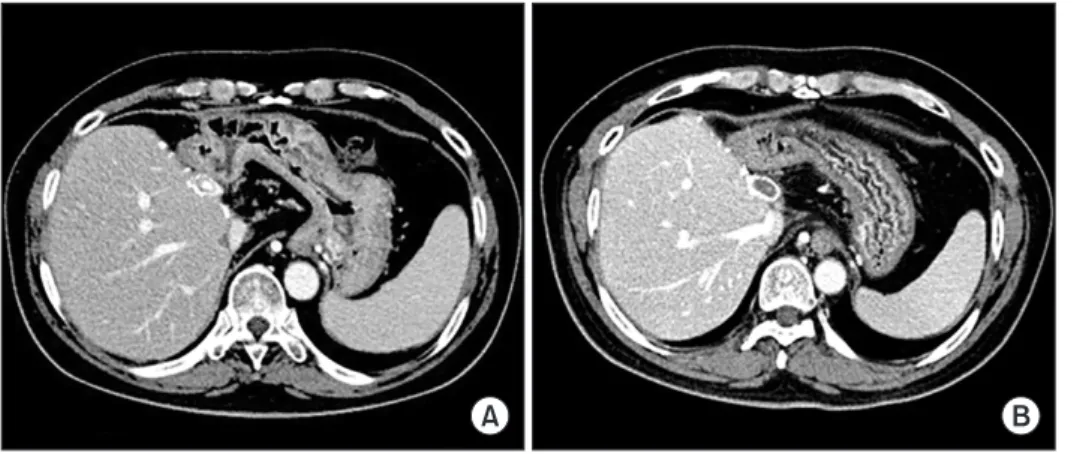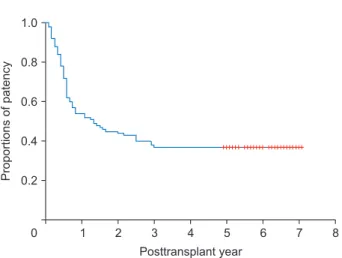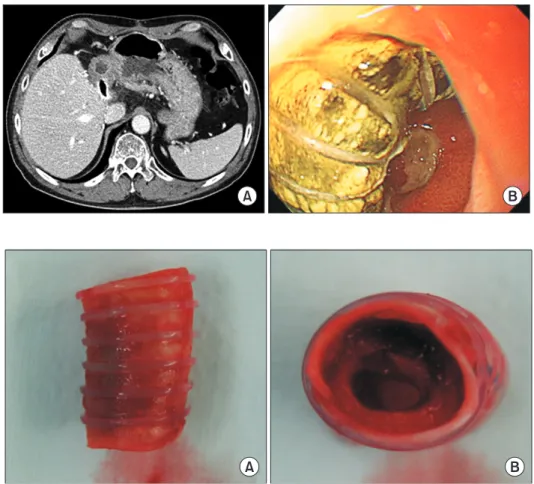Received July 20, 2019 Revised February 4, 2020 Accepted February 17, 2020 Corresponding author: Shin Hwang Department of Surgery, Asan Medical Center, University of Ulsan College of Medicine, 88 Olympic-ro 43-gil, Songpa- gu, Seoul 05505, Korea
Tel: +82-2-3010-3930 Fax: +82-2-3010-6701 E-mail: shwang@amc.seoul.kr
Long-term patency and complications of
ringed polytetrafluoroethylene grafts used for middle hepatic vein reconstruction in
living-donor liver transplantation
I-Ji Jung
1, Shin Hwang
1, Tae-Yong Ha
1, Gi-Won Song
1, Dong-Hwan Jung
1, Chul-Soo Ahn
1, Deok-Bog Moon
1, Ki-Hun Kim
1, Gil-Chun Park
1, Young-In Yoon
1, Yo-Han Park
2, Hui-Dong Cho
1, Jae-Hyun Kwon
1, Yong-Kyu Chung
1,
Sang-Hyun Kang
1, Sung-Gyu Lee
11Division of Hepatobiliary Surgery and Liver Transplantation, Department of Surgery, Asan Medical Center, University of Ulsan College of Medicine, Seoul, Korea
2Department of Surgery, Busan Paik Hospital, Inje University College of Medicine, Seoul, Korea
Background: Homologous vein allografts are adequate for reconstruction of the middle he- patic vein (MHV) in living-donor liver transplantation (LDLT). However, supply is a matter of concern. To replace homologous vein allografts, polytetrafluoroethylene (PTFE) grafts were used. This study aimed to assess the long-term patency rates and complications of PTFE grafts used for MHV reconstruction of LDLT in a high-volume liver transplantation center.
Methods: We analyzed the patency rates of PTFE-interposed MHV in 100 LDLT recipi- ents and reviewed complications including PTFE graft migration.
Results: The mean age was 53.5±5.4 years and male to female ratio was 73:27. Primary diagnoses were hepatitis B virus infection (n=71) and other (n=28). Mean model for end- stage liver disease score was 16.2±8.3. V5 reconstruction was performed as either single anastomosis (n=85) or double anastomoses (n=14). No V5 reconstruction was required in one patient. V8 reconstruction was performed as single anastomosis, double anastomo- ses, and no reconstruction in 75, 0, and 25 patients, respectively. During a mean follow-up of 6 years, three recipients required early MHV stenting within 2 weeks. After 3 months, there were no episodes of congestion-associated infarct, regardless of MHV patency.
Patency rates of PTFE-interposed MHV were 54.0%, 37.0%, and 37.0% at 1, 3, and 5 years, respectively. Unwanted PTFE graft migration occurred in two recipients, and the actual incidence was 2% at 5 years.
Conclusions: PTFE grafts combined with small-artery patches demonstrated acceptably high short- and long-term patency rates. Since the risk of unwanted migration of PTFE graft is not negligibly low, lifelong surveillance is necessary to detect unexpected rare complications.
Keywords: Polytetrafluoroethylene; Prosthetic graft; Hepatic venous congestion; Patency pISSN 2671-8790 eISSN 2671-8804
© The Korean Society for Transplantation This is an Open Access article distributed under the terms of the Creative Commons Attribution Non-Commercial License (http://creativecommons.org/licenses/
by-nc/4.0/) which permits unrestricted non-commercial use, distribution, and reproduction in any medium, provided the original work is properly cited.
INTRODUCTION
Middle hepatic vein (MHV) reconstruction with vascular graft interposition is regarded as one of the standard pro- cedures for living-donor liver transplantation (LDLT) using a modified right lobe graft. Various interposition materials have been used so far, including homologous and autolo- gous vessels and prosthetic vascular grafts [1-4]. Theoret- ically, homologous vein allografts are the best material for MHV reconstruction. However, their supply is very limited due to an extreme shortage of tissue donors in Korea. To overcome the discrepancy between the demand and supply of homologous vessel allografts, prosthetic vascular grafts have been used instead. We previously presented that the short-term patency rate of ringed polytetrafluoroethylene (PTFE) grafts was acceptably high in comparison with that of cryopreserved iliac vein and aorta allografts [5]. How- ever, the long-term patency rate of PTFE grafts remains unclear because there are only a few studies regarding this topic. In addition, accidental unwanted migration of a PTFE graft into the adjacent hollow viscus has been reported from several high-volume transplantation centers that fre- quently perform LDLT [5-11]. In this study, we presented
the real-world long-term patency rates and complications of PTFE grafts used for MHV reconstruction of LDLT in a single high-volume liver transplantation (LT) center.
METHODS
This study protocol was approved by the Institutional Re- view Board of Asan Medical Center (IRB No. 2019-1347).
Study Design
This was a retrospective single-arm study on the out- comes of PTFE graft interposition for MHV reconstruc- tion. The primary aim of this study was to present the real-world 5-year patency rates of PTFE grafts. The secondary aim was to present the actual incidence of un- wanted PTFE migration up to 5-year posttransplant.
Therefore, we designed our study to recruit and assess 100 consecutive LDLT recipients who survived for more than 5 years after primary LDLT with PTFE graft interposi- tion. Mortality cases were intentionally excluded, and the recipients showing hepatocellular carcinoma recurrence were also excluded to avoid unnecessary bias.
During a study period of 36 months from January 2011 to December 2013, we selected 100 cases LDLT in adults using PTFE grafts for the study group. All patients were alive at the end of 2018 and underwent regular follow-up at the outpatient clinic of our institution.
Selecting PTFE Grafts for Reconstruction of MHV
After we established the techniques for MHV reconstruc- tion in 1997, we have tried to reconstruct most sizable MHV branches that are ≥5 mm in diameter. Our indication
A B
Fig. 1. Intraoperative photographs showing
the standardized techniques of middle he- patic vein reconstruction using a composite graft of ringed polytetrafluoroethylene (PTFE) and cryopreserved iliac artery patch.
(A) The hepatic vein branch orifices at the liver cut surface were widened by a ventral cut, and then an arterial patch was sutured to each orifice. (B) A 10-mm-sized ringed PTFE graft was prepared and end-to-side anastomosis was done between the PTFE graft and arterial patch, making a fun- nel-shaped intervening arterial patch.
HIGHLIGHTS
• This study revealed that middle hepatic vein recon- struction using polytetrafluoroethylene (PTFE) grafts demonstrated acceptably high short- and long-term patency rates.
• The risk of unwanted migration of PTFE graft is not
negligibly low, thus lifelong surveillance is necessary.
for MHV reconstruction has been described elsewhere [1- 5]. When any adequately large-sized vessel allograft was not available at our institutional tissue bank, we had to finally select a PTFE graft. Vessel graft material was se- lected primarily by the graft-recipient weight ratio (GRWR) and model for end-stage liver disease (MELD) score.
Surgical Techniques
We used ringed PTFE grafts (GORE-TEX; W. L. Gore and Associates, Newark, DE, USA) of an internal diameter of 10 mm. After making a small niche to enlarge the orific- es of V5 and V8 (segments 5 and 8 of the hepatic vein branches), an intervening allograft patch was attached for the end-to-side anastomosis of MHV branches (Fig.
1). This PTFE graft was anastomosed to the middle-left hepatic vein trunk stump of the recipient. Nonabsorbable monofilaments made of expanded PTFE that reduced needle-hole bleeding from the PTFE graft were used to make redundant composite patch venoplasty for end- to-side branch anastomosis, especially for V8. Details of these procedures have been presented elsewhere [5].
Evaluation of PTFE-Interposed MHV Patency and Indications for Stenting
According to our LDLT management protocol, posttrans- plant dynamic computed tomography (CT) scans were rou- tinely performed every week while patients were in the hos- pital, and at 1, 3, 6, and 12 months after LDLT. Thereafter, follow-up abdomen CT scans were repeated annually for 5 years and biannually after 5 years. We define MHV occlu- sion as a nonvisualization of blood flow in the PTFE graft conduit between V8 (or V5 when only V5 was reconstruct- ed) and the inferior vena cava on dynamic liver CT. When V5 was thrombosed but V8 was patent, we considered it as
patent. When CT scan was not taken due to impaired renal function, information from Doppler ultrasonography was used instead. Interventional stenting of the thrombosed PTFE graft was indicated when significant MHV occlu- sion-related perfusion abnormality developed [12,13]. We classified MHV stenting as MHV occlusion in this study, although MHV patency was regained after stenting.
Statistical Analysis
All numerical data were presented as a mean±standard deviation. Patency rates were determined using the Ka- plan-Meier method and compared using a log-rank test.
Statistical analyses were performed using SPSS IBM ver.
22.0 (IBM Corp., Armonk, NY, USA).
RESULTS Patient Profiles
The clinical profiles of 100 patients that underwent LDLT using a modified right lobe graft, with MHV recon- struction using PTFE grafts, were as follows: the mean age was 53.5±5.4 years; male to female sex ratio was 73:27; primary diagnoses were hepatitis B virus infection (n=71) and other (n=28); MELD score was 16.2±8.3; ABO blood-incompatible LDLT was 15 (15%); and the GRWR was 1.12±0.3.
Configurations of MHV Reconstruction Using a PTFE Graft The sources of vessel patches attached at the V5/V8 orifices were patched cryopreserved iliac arteries and veins, and autologous saphenous and portal veins. Patch unification of two or three small V5/V8 branches was
A B
Fig. 2. Computed tomography images
showing progressive occlusion of the lumen
within the interposed polytetrafluoroeth-
ylene graft, taken after 3 months (A) and 6
months (B). Despite the deprivation of mid-
dle hepatic vein outflow, noticeable hepatic
venous congestion was not developed due
to intrahepatic venous collateral formation.
preferentially used because it enabled us to make a single anastomosis to the interposition PTFE graft. V5 recon- struction was done in a single anastomosis (n=85; 85%, including unification venoplasty), and double anasto- moses (n=14; 14%), and no reconstruction (n=1; 1%). V8 reconstruction was done in a single anastomosis (n=75;
75%, including unification venoplasty), and double anas- tomoses (n=0; 0%), and no reconstruction (n=25; 25%).
Patterns of MHV Graft Occlusion
Serial follow-up CT scans showed that luminal thrombo- sis occurred within PTFE grafts around the V5 anasto- mosis. V5 outflow was gradually reduced, which resulted in concentric thickening of luminal thrombus. At this phase, a PTFE graft with a 10-mm inner diameter was transformed to a narrow conduit with an inner diameter of 3–5 mm. At last, the graft lumen between the V5 and V8 orifices was occluded. Meanwhile, the V8 outflow was maintained for a longer period (Fig. 2).
PTFE-Interposition MHV Patency
During a mean follow-up of 6 years, three patients (3%) re- quired MHV stenting. All of them underwent early stenting within 2 weeks after LT and MHV flow was restored. After 3 months, there were no episodes of congestion-associat- ed hepatic infarct, regardless of MHV patency. The actual patency rates of PTFE-interposed MHV were 54.0%, 44.0%, 37.0%, and 37.0% at 1, 2, 3, and 5 years, respectively (Fig. 3).
Unwanted Migration of PTFE Graft into the Adjacent Hollow Viscus
Ringed PTFE grafts in two patients accidentally penetrat- ed the gastric wall and each had to be removed by explor- atory laparotomy at 6 months (Fig. 4) and 3 years (Fig. 5) posttransplant [6]. These two patients did not show any symptoms or signs indicating vascular complications at the time of detection. PTFE migration was detected on routine follow-up CT scans and gastric luminal penetra- tion was confirmed by endoscopic examination. In this study, the actual incidence of unwanted migration of the PTFE graft at 5 years was 2%. A majority of the occluded PTFE grafts remained silent as foreign bodies even after thrombotic luminal obliteration.
DISCUSSION
MHV reconstruction resulted in a new demand for vascular allografts in the field of LDLT. Moreover, the increase in LDLT volume lead to relative shortages in the supply of vessel allografts. We have used every available vessel material for MHV reconstruction. Cryopreserved iliac vein allografts have been traditionally regarded as the most suitable interposition material for MHV reconstruction. However, the most serious problem is its limited availability.
In regard to availability, prosthetic vessel grafts have a definite merit of unlimited supply. The short- and long- term patency rates of ringed PTFE grafts were acceptably high, as shown in this study. We previously reported that the 6-month patency rates of MHV interposition grafts were 75.3% with cryopreserved iliac veins, 35.2% with iliac arteries, 92.3% with aortas, and 76.6% with ringed PTFE grafts [5]. We think that such high patency rates are primarily due to the surgical techniques that use ringed PTFE grafts for the following reasons: the protective ef- fect of the outer rings against extrinsic compression;
offset against the stenosis-inducing effects from tissue reactions after placing a composite artery patch between the V5/V8 orifice and PTFE grafts [14]; and the construc- tion of a streamline-shaped, endothelial cell-lined internal tunnel within the luminal thrombus of the PTFE graft [5].
Such an internal pathway acts like a narrow neointi- ma-lined conduit with an internal diameter that is adjust- ed by the passing blood flow volume [15].
PTFE grafts have the definite advantage of unlimited supply and appear promising due to improved luminal
0 1.0
0.8
0.6
0.4
0.2
8
Proportionsofpatency
Posttransplant year
1 2 3 4 5 6 7
+ + + + + + + + + + + + + + + + + + + + + + + + +
Fig. 3. A curve of the luminal patency at the polytetrafluoroethylene
graft-interposed middle hepatic vein trunk.
patency. Although PTFE grafts have some nonnegligible disadvantages such as longer bench work time and re- quirement of a small vessel patch for composite grafts, most of these demerits are acceptable or manageable.
However, unwanted migration of a PTFE graft into the hollow viscus is an unexpected serious complication [6,7].
Migration of such a foreign body into the stomach or du- odenum can induce life-threatening complications that require surgical removal. We presume that the underlying mechanism of unwanted PTFE graft migration is based on inflammation against a foreign body. Inflammation-in- duced adhesion might facilitate the migration of a PTFE graft into the adjacent hollow viscus. Its real-world 5-year incidence was estimated to be 2% in this study. A majority of the occluded PTFE grafts remained silent as foreign bodies after thrombotic luminal obliteration, which can be a potential source of other rare complications later.
Hsu et al. [7] reported that PTFE-related complications developed in 1.5% (4/262) of patients. One patient devel- oped complete thrombosis with sepsis at 24 months and died due to multi-organ failure. Three patients developed
graft migration into the second portion of the duodenum, without overt peritonitis. Surgical exploration and PTFE graft removal was done in all three patients. One patient died due to overwhelming sepsis.
Considering the benefits and complications of PTFE grafts, the grafts are currently regarded as vascular substi- tutes of “necessary evil.” Considering that massive hepatic venous congestion from exclusion of MHV deprivation is one of the leading causes of graft failure, the abovemen- tioned demerits from PTFE-associated complications are not great enough to abandon the use of PTFE grafts. In conclusion, ringed PTFE grafts combined with small-artery patches demonstrated acceptably high short- and long- term patency rates. Since the risk of unwanted PTFE graft migration is not negligibly low, lifelong surveillance is nec- essary to detect unexpected rare complications.
A B
Fig. 4. Image findings of the polytetrafluo-
roethylene (PTFE) graft migration. (A) Com- puted tomography taken 6 months after liver transplantation showed partial penetration of the PTFE graft into the stomach. (B) An endoscopy showed complete penetration of the PTFE graft into the gastric lumen.
A B
Fig. 5. Gross photographs of the excised



